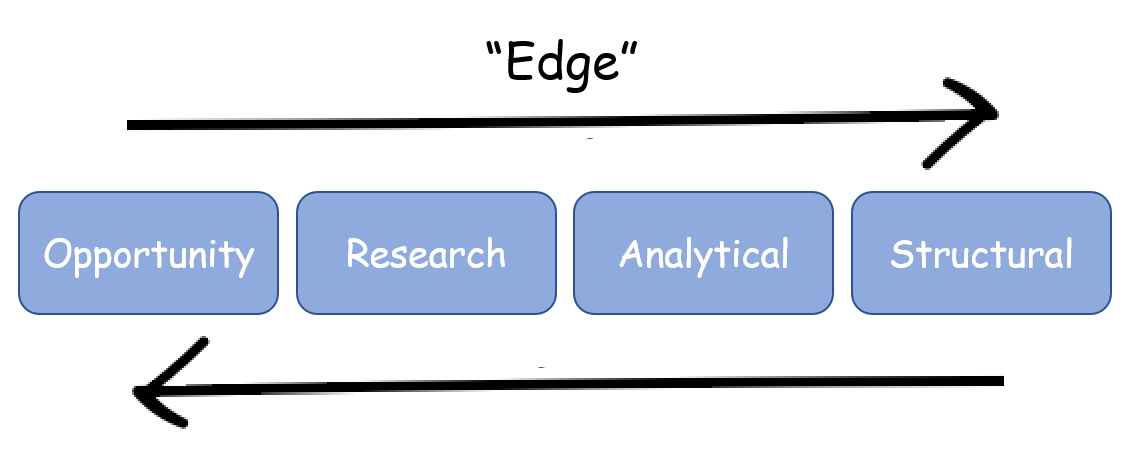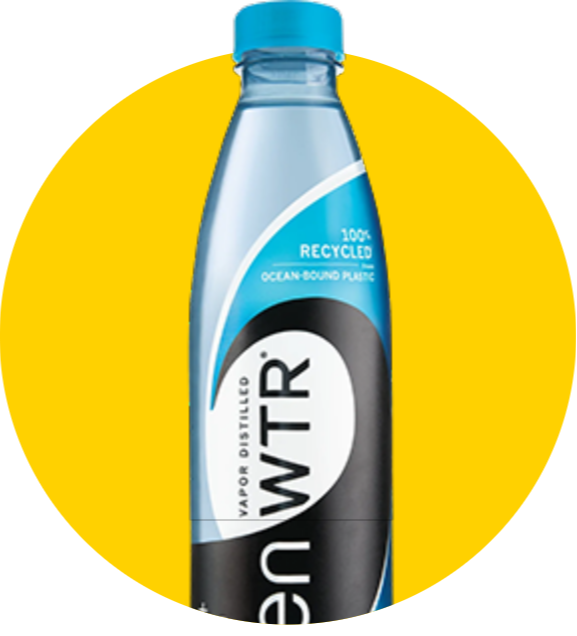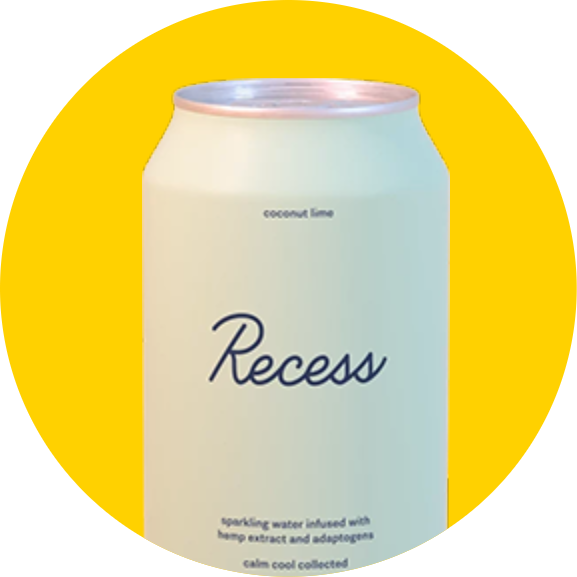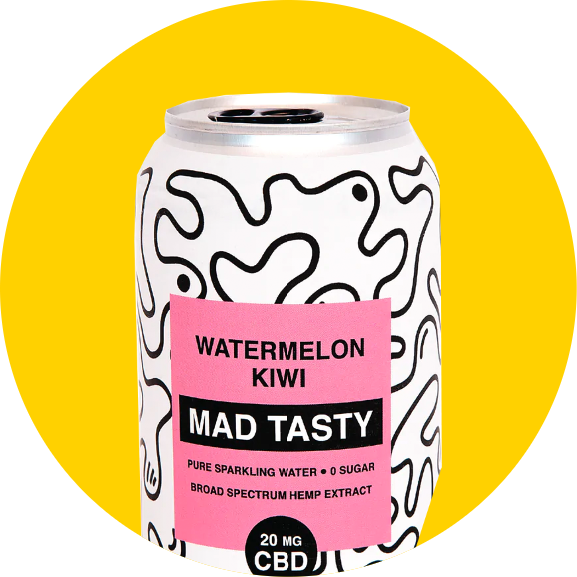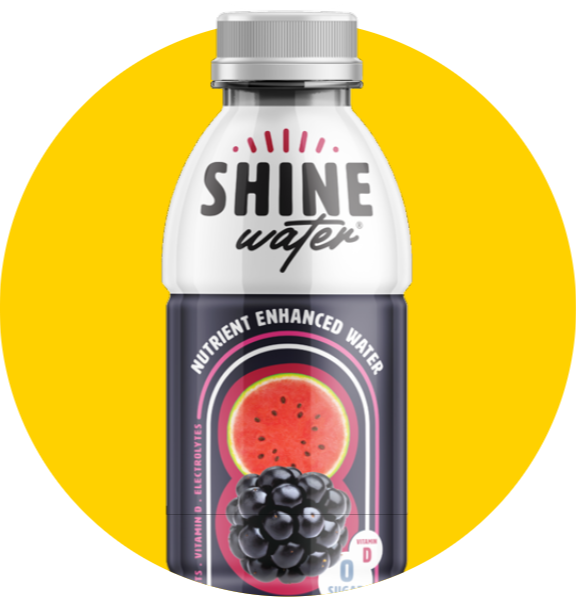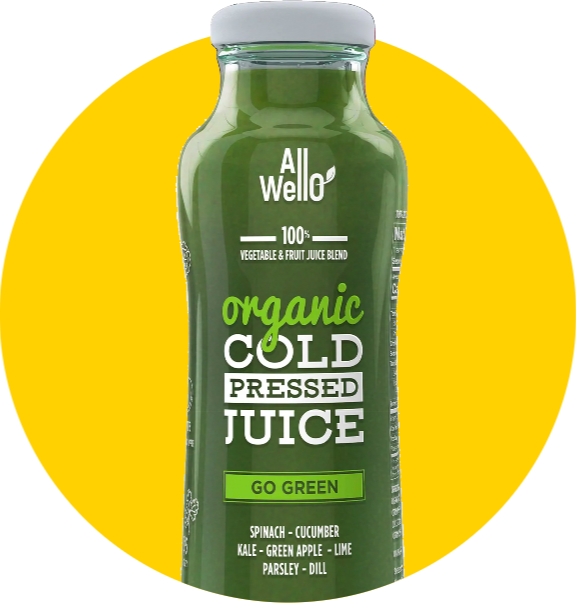Part of building a new way of approaching private investing with data science is studying how others have succeeded in disrupting their own industries. Lately for me that’s been a fascination of learning from public market investors, brought about by Patrick O’Shaughnessy’s podcast Invest Like The Best. Earlier this year, Patrick interviewed Jason Karp, Founder and CEO of Tourbillon Capital Partners and Co-Founder of Hu Products (sidenote, if you haven’t tried their chocolate then get ready for your life to change).
Jason had a philosophy that I really liked — the gist is, in public market investing you have 3 sources of edge, each one more important and sustainable than the last: research (access to information), analytical (what you do with that information), and structural (the amount of time you have to be right). I wanted to take a stab at unpacking that, and to add a fourth component, to see how his framework holds for private market investing.
Public Markets

Ranked from least to most in both importance and sustainability
Opportunity: This is my addition — it will make more sense later — but it goes without saying that in the public markets every investor has the same universe of stocks to invest in. A larger investor may struggle more to buy or sell an illiquid stock, but you cannot compete on “dealflow”.
Research: We’ll assume ethical practices across all parties for this one, but it’s not just the laws and regulations that make this true. The vast array of clean data sets in time series that are available to hedge funds create advantages that can be very powerful (e.g. analyst earnings estimates or the number of parked cars in WalMart parking lots). The issue — once that power is realized, and your competitors adopt the same data, your advantage is arbitraged away. Much of this data isn’t proprietary — it can be bought, and so once it’s known to work it will be bought by your competitors.
Analytical: For a fundamental value investor this will be a combination of decision making frameworks, market outlook and a process to govern repeatability. For a more quant-focused investor, this might be a complex regression or machine learning model to process all of the information described above and make a decision. Either way, there is real differentiation here and the methods are proprietary.
Structural: Ranking this #1 in importance and sustainability is just to say that you’re only as good as your ability to let your process run its course. Two things typically determine how successful an investor can be in that sense: their emotions and their capital base. Much has been written about both, so I’ll summarize Karp’s view that an investor able to trust their process during short term turbulence, with LPs that hold on for the long-term, will be the most sustainably successful in the long-term.
Private Markets
When faced with ranking these four factors in the private markets, I had two reactions: first, there is really no factor that is commoditized to the extent that dealflow and information are in public investing; second, the order in importance and sustainability really do seem to be flipped. I’ll talk through my thinking below in the context of CircleUp and Helio.
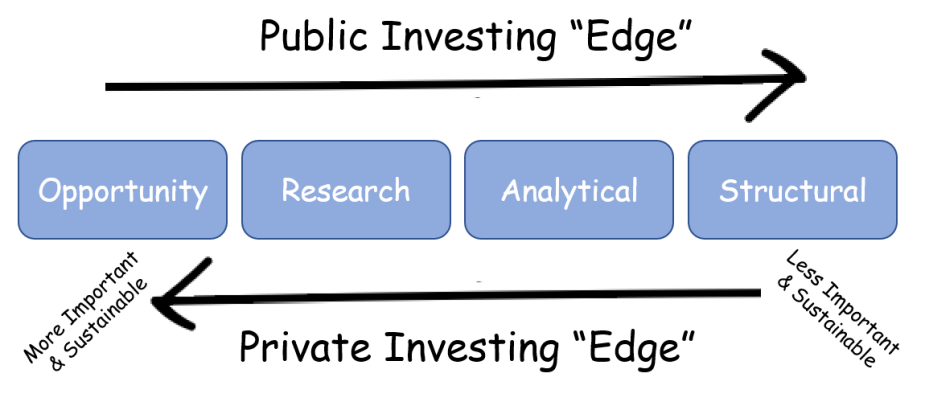
Structural: This is not to understate the impact of future fundraising or the permanent capital enjoyed by some investors (family offices, sovereign wealth funds) — it is more to say that the norm is for a private equity investor to enjoy a 10 year fund with committed capital and far less liquidity to be tempted into selling low. There is still value to being a more long-term thinker than your competitors, but the playing field is more level here.
Analytical: At a typical PE/VC fund, this is the process to drive discipline and repeatability, and the pattern recognition to form a differentiated insight. At CircleUp, this is Helio’s algorithms — models that introduce accuracy, objectivity and repeatability to evaluation. They are entirely proprietary and very powerful, but only as powerful as the data sets they sit atop…
Research: This is the essence of Helio. Clean, relevant data in time series to describe the underlying fundamental drivers of consumer brands. There is a common understanding in the world of machine learning that more data beats a better model, and that could not be more true here. What’s more, the challenges of collecting, cleaning and deploying data at scale are so difficult that the majority of private investors haven’t tried. It’s a big reason why our engineers and data scientists outnumber our investment professionals at CircleUp.
Opportunity: At the end of the day, your ability to predict the future is only as good as your ability to act on it. My first mentor in the investing world used to always tell me an important lesson: “investing is a service business — everybody’s money is green”. Companies want more than just capital, and rightfully so, meaning that the onus is on us as investors to prove what value we can deliver to earn our place on a company’s cap table. I believe firmly that as the private markets become more efficient, adding value to companies post-close will become more and more important.
So What?
Save for being just a generally neat pattern (which I encourage any readers to disagree with and challenge my thinking here), to put it bluntly, who cares?
Information as a Bridge: Private investors ultimately compete on proprietary dealflow and pattern recognition, but there is very little network effect between the two. Doubling down on an information advantage importantly feeds both of your core capabilities — models and processes get stronger with more data, information and advice you provide to companies becomes more unique, objective and valuable. The short term result should be more informed and objective investment decisions. The long term result? More value added to those companies and more desire from others to work with you.
Double Down: If proving value to companies is ultimately the most important way to compete, then we should spend our time doing just that. Everyone approaches this problem differently — at CircleUp we use Helio. By creating an information advantage, we make faster decisions and unlock more time in the day to help our companies post-close. By emphasizing interpretability, we get to share insights with our companies that only we have access to.
Time will tell if the importance of data holds true as the private markets continue to evolve, but there is a cost to the “wait and see” approach. If more data really does beat a better model, we’ll all wish we’d started collecting it years ago…
This post first appeared on Kiva’s Medium
Zen Water
A water brand with an estimated revenue of $10-$20M (a +407% YoY increase)
Recess
A carbonated drink brand with an estimated revenue of $10-$20M (a +104% YoY increase)
Mad Tasty
A water brand with an estimated revenue of $1-$5M
Shine Water
A water brand that is in 3,000 retail doors (a +329% YoY increase)
All Wello
A juice brand with an estimated revenue of $1-$5M (a +89% YoY increase)
By understanding how these trends will impact the CPG landscape, you can position your business for success.
To learn more about Helio or get in touch, visit heliodata.com.

